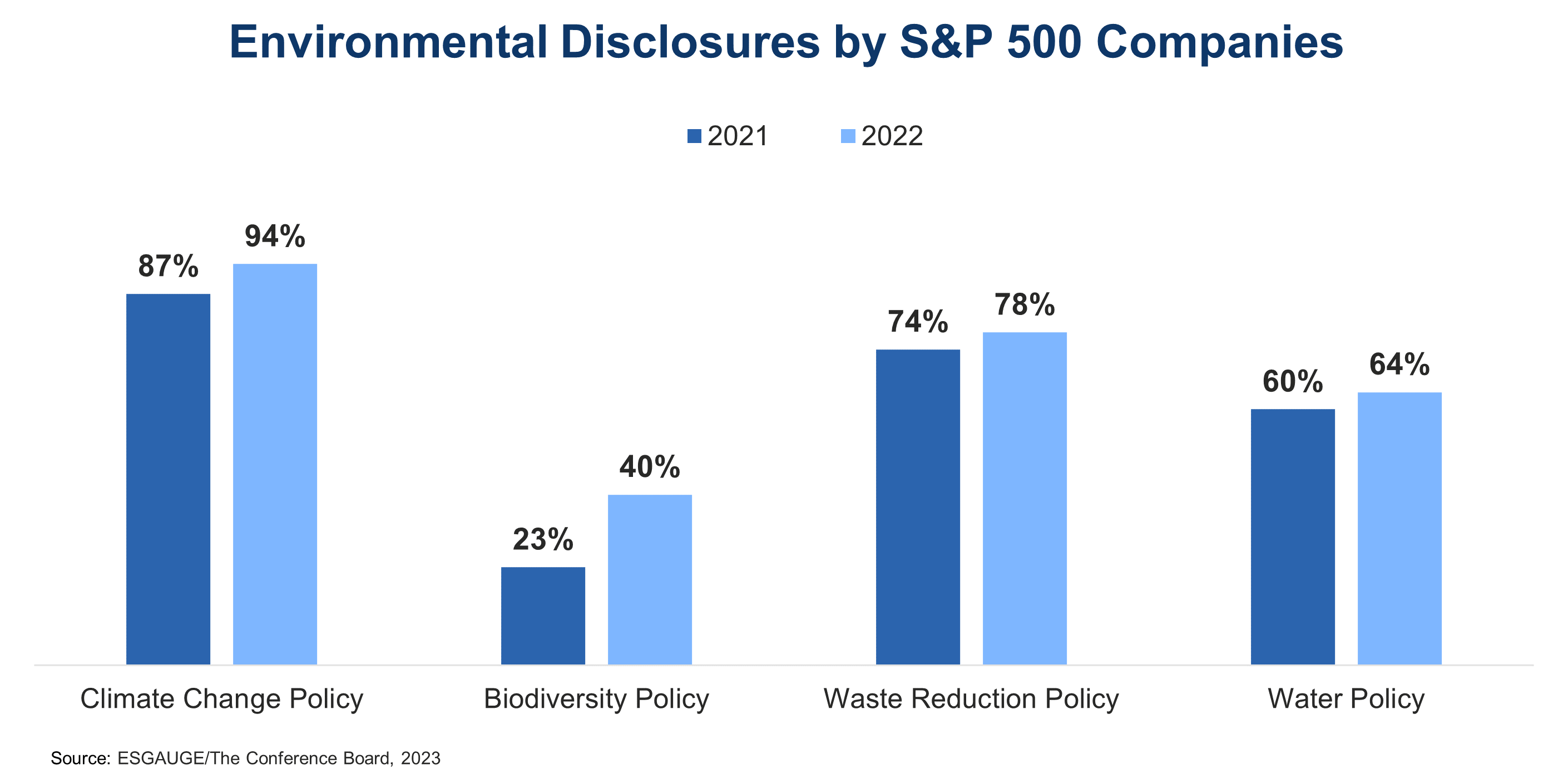


Members of The Conference Board get exclusive access to the full range of products and services that deliver Trusted Insights for What's Ahead ® including webcasts, publications, data and analysis, plus discounts to conferences and events.
09 November 2023 / Quick Take
Over the past two years, a growing number of S&P 500 companies have been disclosing information on key environmental areas. But the prevalence of disclosure varies significantly: climate continues to be the most commonly disclosed area, followed by waste, water and, trailing far behind, biodiversity.
Insight for What’s Ahead: Companies should consider placing greater emphasis on biodiversity, as it has significant potential to become a cornerstone of environmental strategy and disclosures. First, there is a strong business case for focusing on biodiversity since over half the world’s total GDP is highly or moderately dependent on it: industries ranging from agriculture to medicine to travel and tourism depend on the variety and abundance of life. Second, protecting biodiversity is key to addressing other areas such as climate change mitigation (as plant life sequesters carbon), water quality (as it naturally filters water), and waste reduction.

Furthermore, biodiversity is an area where companies can have a direct and meaningful impact through their own operations and supply chains.
More broadly, companies should consider environmental issues holistically. Climate, biodiversity, waste, and water are all substantively interrelated. In business planning, it is far more efficient to engage the board and senior management on relevant environmental issues as a whole than in silos. And as strategies are implemented, specific projects may simultaneously tackle multiple environmental issues, such as biodiversity, climate, water, and waste. Finally, regulation such as the EU’s Corporate Sustainability Reporting Directive is likely to prompt increased disclosure across multiple environmental areas.
For more on the topic of corporate focus on biodiversity, see Biodiversity as a Cornerstone of Corporate Environmental Strategy. For more statistics on environmental and other ESG disclosures, please visit our Live Dashboards on ESG Advantage, powered by ESGAUGE.
Over the past two years, a growing number of S&P 500 companies have been disclosing information on key environmental areas. But the prevalence of disclosure varies significantly: climate continues to be the most commonly disclosed area, followed by waste, water and, trailing far behind, biodiversity.
Insight for What’s Ahead: Companies should consider placing greater emphasis on biodiversity, as it has significant potential to become a cornerstone of environmental strategy and disclosures. First, there is a strong business case for focusing on biodiversity since over half the world’s total GDP is highly or moderately dependent on it: industries ranging from agriculture to medicine to travel and tourism depend on the variety and abundance of life. Second, protecting biodiversity is key to addressing other areas such as climate change mitigation (as plant life sequesters carbon), water quality (as it naturally filters water), and waste reduction.

Furthermore, biodiversity is an area where companies can have a direct and meaningful impact through their own operations and supply chains.
More broadly, companies should consider environmental issues holistically. Climate, biodiversity, waste, and water are all substantively interrelated. In business planning, it is far more efficient to engage the board and senior management on relevant environmental issues as a whole than in silos. And as strategies are implemented, specific projects may simultaneously tackle multiple environmental issues, such as biodiversity, climate, water, and waste. Finally, regulation such as the EU’s Corporate Sustainability Reporting Directive is likely to prompt increased disclosure across multiple environmental areas.
For more on the topic of corporate focus on biodiversity, see Biodiversity as a Cornerstone of Corporate Environmental Strategy. For more statistics on environmental and other ESG disclosures, please visit our Live Dashboards on ESG Advantage, powered by ESGAUGE.
Former Senior Researcher, Governance & Sustainabil…
The Conference Board
You already have an account with The Conference Board.
Please try to login in with your email or click here if you have forgotten your password.

